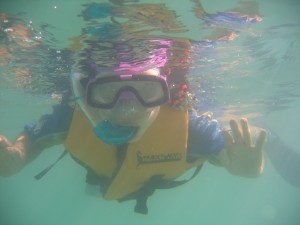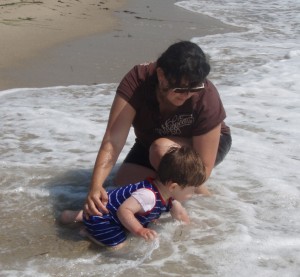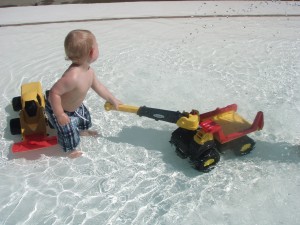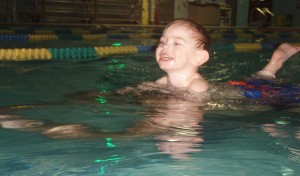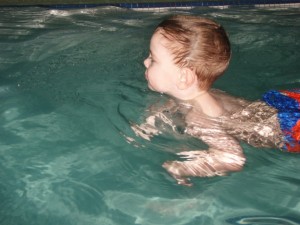Swimming is one of the primary motor skills every human being should acquire. Why? It may save your life some day.
So how do you go about teaching your child to swim? There are many excellent swimming programs available and this site does not intend to be an exhaustive guide in swimming skill development. As a swimming instructor for many years, however, it became evident that if the child’s early experiences with water are unpleasant, it is difficult to erase that initial fear.
Children have an intuitive sense of parental anxiety, so if during the first exposure to water a sense of anxiety in Mom or Dad is felt, it can make it really hard for them to overcome reluctance and initial fear of the water.
Here are some preliminaries that get you off to a great start.
Benefits:
1. Swimming uses all the muscles in the body, so it is an over all body strengthener.
2. Both sides of the body move together in one motor sequence or another depending on the stroke so it is a great bilateral activity.
3. Each swimming stroke requires a different motor sequence so as the child develops proficiency and begins to explore new strokes, motor sequencing is enhanced.
4. Water play offers many novel experiences so once a child can swim, this arena provides many motor planning opportunities.
5. Once a child is a proficient swimmer, positive social experiences occur poolside, beachside or lakeside!
Directions:
There is no one way to teach swimming. The following provides general guidelines to consider when introducing water and early swimming experiences.
Infants and babies:
Help your baby become comfortable with the sensation of water. It feels different on the skin. If you gently place your infant in neutral (temp) water soon after birth there is very little adjustment since that baby will have some residual sensory memory of living in water in utero. There are many infant swimming programs* that introduce infants to the water.
With water temperatures comfortable, when at a pool, lake or other body of water, hold your baby securely; gently and gradually submerge (not the face) your infant in the water. Bobbing, cradling and rocking in the water can be enjoyable and soothing.
With older babies, distract and engage in the water sensation with singing, dancing and mixing some ooos and ahhhs along the way. Help the baby recognize that this is a new and different sensation but it is fun and will become pleasant over time.
Toddlers:
Once the baby has solid control in sitting, including reaching without falling over, the child can be placed in a small tub of water or a kiddie pool to play. Vigilance is still essential, since people can drown in one inch of water. As the toddler becomes comfortable in the water, play games that require moving around. This will lead to crawling through the water. As the child gets braver, s/he might pretend to swim. Joining the baby in the pool is a very effective way to model swimming behavior. Children love company. They get a huge kick out of having a grownup in a kid’s space.
In grownup swimming places (pools, lakes, ocean), holding the toddler (as described above for the infant) can occur. Less support as the child becomes comfortable in the water can happen as well. If the child learns how to hold his or her breath you can do dunking games with “Are you ready, are you ready…” Demonstrate and exagerate holding your breath as you go under momentarily. If the child loves the water, you can hold the upper portion of those tiny arms and move the little body around in a circle in a swish swish way so the child begins to gain the sensation of floating.
I used flotation devices very infrequently with my own children. Perhaps it is because I remember how much I hated them as a child or because I found it so much more engaging, effective and fun to facilitate floating and developing a love of the water by supporting the kids myself.
Independent water exploration can occur with a gradual slope. The child sits and splashes, watches the waves gently come in and out and can begin to play with and reach for toys. As the toys go deeper, the child has to reach further. Remember, close observation is a must and no more than an arms length away while the toddler plays “independently.”
I love the wading pools that have a very gradual slope. Pictured below, this 15 month old barely notices that he is getting deeper in the water as he plays with the trucks. And not to worry-it never gets deeper than his thighs.
And don’t underestimate the role of observation. Watching other children, especially slightly older, play and have fun in the water can be a huge motivator for children. Peer pressure (in a good way) begins earlier than you think!
Preschool and Older:
I lump these together because a child can begin to learn basic strokes at four years old. It’s a matter of refinement and endurance after that. I will give some tips on building specific skills. If you are a swimmer and your child loves playing in the water with you, swimming instruction can take place easily by you and other water loving family members. If your child is a reluctant swimmer or you feel anxious about the water, invest in some swim classes at a local Y, community program or club. Creating a confident swimmer is not the same as developing a good soccer player. It can be the matter of life and death. You want your child to be able to swim!
Getting used to the sensation of water on the face:
This can begin in the tub. Have the child dip the face in the water. A wash cloth can be at the ready to wipe if the sensation is not well tolerated. Always repeat a few times. Laugh so the child associates the sensation of “different” as “fun.” Transfer to pools, lakeside and the beach. You can do the dunking exercise described for toddlers or have the child initiate independently.
Blowing bubbles:
This is the next step after face immersion. Make sure the child understands to inhale out of the water and then blow bubbles at the surface of the water. I do this with children stationary first (usually sitting and bending over the water). After the child masters this, you can pull the neophyte swimmer for a ride in the water as the head dunks and blows bubbles. I call this “Motor Boat.”
Holding Breath:
It is critical that the child learns how to hold breath under the water and feel confidence about this. Dunking games are the best way to make this a fun exercise.
Eventually you want the child to do hold breath and breathe in a sequenced rhythmical way. Slow counting can help with this. This is a necessary precursor to basic swimming strokes.
Kicking:
The children can hold onto the side of the pool or stabilize the body in the shallow part of a lake/beach and practice a kicking motion. Sometimes you need to move the legs up and down to give them the “feeling” of a kick. You can then transfer this to pulling the child while holding a kick board and propel with kicking (but you are doing most of the work initially).
Floating:
This is the most important skill as it can be a life saver. Floating allows the child to glide through a stroke, and take rests when tired. In order to float, the child has to be comfortable in the water. That is why the skills reviewed above should be taught first. As the child gains confidence in the water, the body relaxes and the floating can occur naturally. A tense child does not learn to float!
Early swimming:
I spoke about “practicing swimming” in shallow water. The child lies tummy down in the water and the arms move as if doing a crawl stroke, moving across the pool in this fashion. With movement, the child experiences the sensation of floating.
Doggie paddle is a great way to get started. It keeps the child’s head above water as the arms get stronger. It takes a while to be able to lift the arms out of the water as required for crawl or freestyle. Along with strengthening and training the arms to approximate the stroke, the child needs confidence in a partial float/glide as the movement occurs. Therefore, doggie paddle allows the child to get used to swimming without assistance while still developing the components necessary for better swimming.
Games to play to encourage independent swimming:
Jumping into the swim coach’s arms is a fun game; gradually move back so the child has to reach for you. Make sure you monitor the child’s readiness for this.
Retrieving toys from under the water: begin with very shallow water so reaching is easy. Gradually place objects in slightly deeper water so eventually the head needs to submerge momentarily to obtain the toy.
Wade/swim races: Set up courses in shallow water where the child can run or swim. Because of the water’s resistance it is easier to combine a lunge forward, float and stand kind of movement. This can gradually transition into a modified swim/float type movement as the child becomes familiar with how the body parts can move in the water.
Most of the games in the following site can be adapted to the shallow end of a swimming area:
http://www.buzzle.com/articles/swimming-pool-games-for-kids.html
Games for the proficient swimmer:
These sites list many ideas. I am not endorsing any in particular-they are just ideas. Use your judgement based on the group playing and the environment to make sure the games stay safe.
http://www.parentsconnect.com/parenting-tips/best-water-games-kids.html
http://www.thesource4ym.com/games/swim.asp
Help for the Reluctant Swimmer:
There are special therapeutic swimming programs available. Many of these are geared not just for special needs children but also for “regular” kids who struggle to work in a group or simply need more one on one attention. Some children have sensory processing difficulties so it takes longer for them to acclimate to the sensory demands of the water.
Here’s some generic information about aquatics therapy programs:
http://www.ncpad.org/exercise/fact_sheet.php?sheet=257&view=all
Check out if the fabulous Aquatics program, called Angelfish is available near your area. While the primary medium is the water, parents find the program almost miraculous in the positive changes that occur when their children attend this program. For information:
A great exercise to fight Child Obesity:
http://thechart.blogs.cnn.com/2011/06/23/1-in-5-kids-carry-too-much-weight-before-kindergarten/
Resources for infant swimming programs:
http://www.infantswim.com/company/index.html
http://www.infantaquatics.com/ (Entertaining video included)
http://www.babyswimming.com/FAQ.htm
http://www.uswim.com/ (Includes instructional video from Australia)
